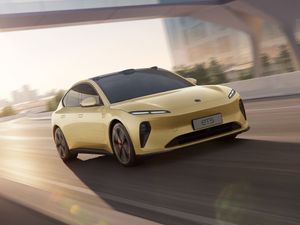Nio ET5 revealed as rival to the Tesla Model 3
Chinese firm reveals its mid-sized electric vehicle with 620-mile range.

The Nio ET5 has been revealed as the latest competitor to the Tesla Model 3.
The Chinese EV promises a hugely impressive 620 miles of range, but there is currently no confirmation whether its European sales ambitions include the UK.
Sporting a sleek roofline, the ET5 has autonomous driving sensors incorporated into its design. It takes styling cues from the firm’s other models, such as the ET9 supercar and larger ET7 saloon.
The ET5 has quite a minimalist design with few flicks and tricks on the bodywork and slim headlights, all with a focus on aerodynamic efficiency.

Inside, you’ll find Nio’s ‘second living room’ design concept that has been inspired by modern design trends in furniture, fashion and footwear. It’s bright and airy inside thanks to large windows and a panoramic roof.
It features recycled and sustainable materials, while ‘invisible’ air vents were developed for a cleaner design.
Technology is at the forefront of the Nio’s design and as such it gets advanced digital displays that use augmented and virtual reality relayed via special glasses that can project a screen equivalent to 201 inches.
Autonomous driving capabilities are also included, with these being developed and introduced over time.
Perhaps most intriguing of all is the claimed range of up to 620 miles. This is promised with the largest battery, which has a capacity of 150kWh, while smaller alternatives are available. An entry-level 75kWh option can go 342 miles while a 100kWh version brings a claimed range of up to 435 miles.
Deliveries are expected to begin in September 2022 for the Chinese market, with introductions to Norway, Germany the Netherlands and Denmark coming later.
Although Nio is pushing to sell vehicles in new markets across Europe, there are no confirmed plans for the Chinese firm to sell cars in the UK. However, it hopes to ‘establish its presence in over 25 countries and regions worldwide’ by 2025.





